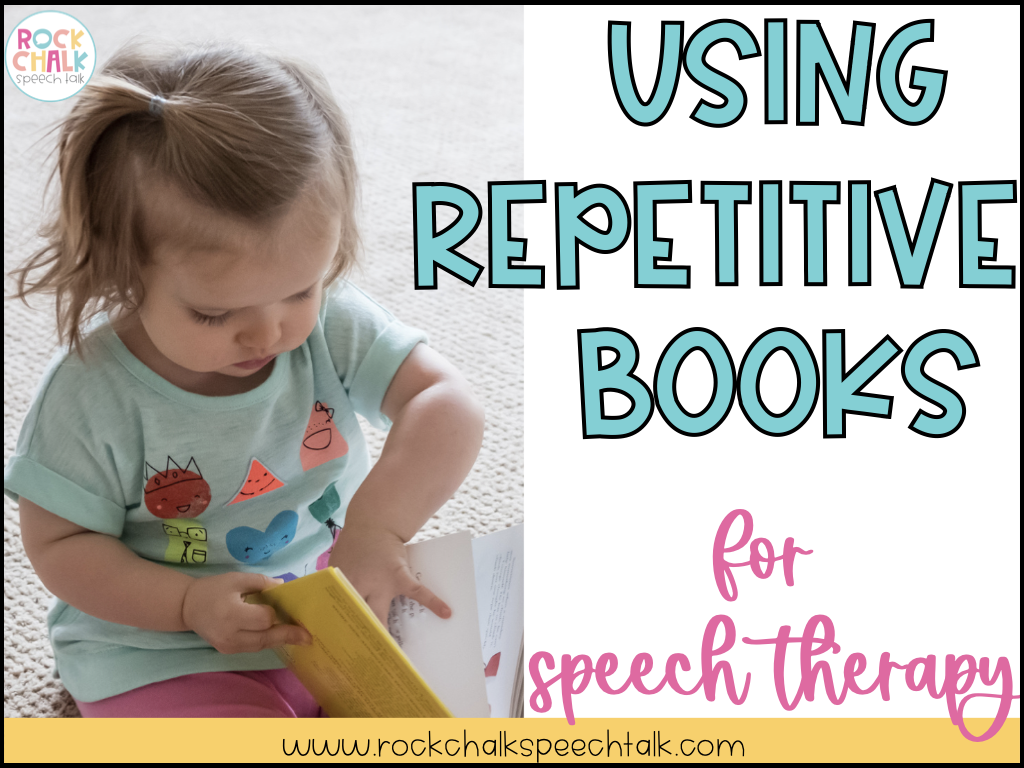We all know reading books is an evidence-based practice to facilitate various aspects of language development, but what about using repetitive books, specifically, in speech and language therapy?

Rhythmic and predictable language found in repetitive books help to capture children’s attention, along with being useful in a variety of other ways!
1. Increased engagement
Repetition of words/phrases throughout the story creates familiarity and predictability. This repetition creates more opportunities for engagement because it allows your students to participate in fill-ins or “read” along with the story with you. When they know what the story “says” and can do this, they feel confident about their skills, which contributes to positive experiences around reading!
Why are positive experiences around reading important? The National Reading Panel found the best readers read the most and the worst readers read the least. Not surprising, right? That being said, the studies they pulled from are correlational in nature, and correlation doesn’t imply causation. So, while it could be that the more that children read, the more their reading skills improve, it could also be true that better readers just choose to read more.
But… without developing intrinsic motivation to learn (in this case, learning to read), the potential for skill carryover drops significantly. Choosing fun books that facilitate engagement and participation can inspire children to want to read more, naturally creating more opportunity for carryover.
2. Decreased “cognitive load”
Repetitive books are predictable, and predictability decreases the “cognitive load,” or, how much effort is needed to process and comprehend what’s being said. When there’s fewer cognitive demands, children can focus more on other aspects of language, such as answering questions about the story, making comments about the story, or relating it to a personal experience.
3. Blocked Practice for Motor Planning Speech Disorders
Children with motor planning speech disorders like apraxia of speech are at risk for reading delays, so incorporating literacy into therapy allows us to also target pre-reading skills like phonemic awareness.
When treating apraxia of speech, both blocked and random practice have been proven beneficial for treatment gains. If you’re not familiar: blocked practice involves repeated practice of the same motor skill, while, as you can probably infer, random practice involves practicing different skills in different, unpredictable orders.
Repetitive books with a target word are great opportunities to incorporate repeated, blocked trial practice with a target word or words.
4. Early Inferencing/Predicting Skills
Since repetitive books are predictable, children are able to anticipate what’s coming next. This helps develop early prediction and inferencing skills, which contributes to building a strong foundation of basic reading skills.
5. Other Speech Sound Practice
I mentioned above that children with apraxia are at risk for reading delays, but it’s also true that children with other speech sound disorders are at risk, as well— meaning it’s important to incorporate literacy into therapy with these kids, too.
Repetitive books that have words with a target sound for phonological processes you’re working on (think /s/-blend heavy books or books with lots of /k, g/ words for fronting) are great opportunities to incorporate repeated speech sound trials into literacy-based therapy.
What are some of your favorite repetitive books? As I write more posts about individual repetitive books, I’ll link them below!

[…] to the tune of “10 in the bed”, and song books are generally always a hit with my kids! In a previous post, I wrote about the role of repetitive books in therapy, some of which involved speech sound […]